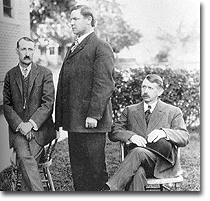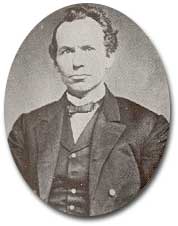37c. Early National Organizations

Defendants in the Steunenberg murder case, Charles Moyer, Bill Haywood, and George Pettibone.
Divide and conquer. That simple strategy gave the owners the advantage over labor until the dawn of the 20th century. Laborers did not all have the same goals. By favoring one group over another, the bosses could create internal dissent in any union. Unions were spread from town to town. Unity among them might make a more effective boycott or strike, but bringing diverse groups together across a large area was extremely difficult.
Owners were smart enough to circulate blacklists. These lists contained the names of any workers active in the union. If anyone on the list would show up in another town trying to get hired (or to start another union), the employers would be wise. Still, the ratio of labor to management was so large that national organization was inevitable. The first group to clear the hurdles was the National Labor Union.
William Sylvis and the NLU

William Sylvis worked in many trades in his life, from wagon making to canal boat building. Later, he became a pioneer in organizing and motivating labor unions.
By 1866, there were about 200,000 workers in local unions across the United States. William Sylvis seized the opportunity presented by these numbers and established the first nationwide labor organization, named the National Labor Union. Sylvis had very ambitious goals. Not only did the NLU fight for higher wages and shorter hours, Sylvis took labor activity into the political arena. The NLU supported legislation banning prison labor, land reform laws to keep public holdings out of the hands of speculators, and national currency reform to raise farm prices.
It brought together skilled and unskilled workers, as well as farmers. The National Labor Union stopped short of admitting African Americans. Racist tendencies of the times prevailed, despite the wisdom of bringing as many workers as possible into the fold. Unfortunately for the NLU, it tried to represent too many different groups. Farmers had their own agenda, and skilled workers often had different realities than the unskilled. When the Panic of 1873 hit America, the union was severely disabled. Soon after, the National Labor Union withered away.
The Knights of Labor
The Knights of Labor soon inherited the mantle of organized labor. Begun by Uriah Stephens as a secret society in 1869, the Knights admitted all wage earners into their ranks, including women and African Americans. The philosophy was simple: class was more important than race or gender. For such a group to influence the federal government, complete solidarity would be required.
The Knights supported the entire political agenda of the NLU and more. They advocated limits on immigration, restrictions on child labor, and government ownership of railroads, telegraphs, and telephones. At the height of its membership in 1886, the Knights boasted 750,000 workers. But then disaster struck.
Tragedy in Haymarket Square
On May 1, 1886, International Workers Day, local chapters of the Knights went on strike demanding an eight-hour day for all laborers. At a rally in Haymarket Square in Chicago on May 4, someone threw a bomb into the crowd. One police officer died and several crowd members sustained injuries.
Who was responsible? No one was really sure, but the American press, government, and general public blamed the Knights of Labor. Leader Terence Powderly condemned the bombing to no avail. Americans associated labor activity with anarchists and mob violence. Membership began to fall. Soon the Knights were merely a shadow of their former size. But labor leaders had learned some valuable lessons. The next national organization of workers would endure.






